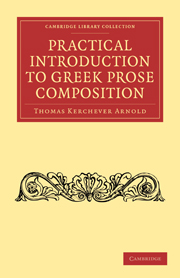GREEK EXERCISES
Published online by Cambridge University Press: 04 April 2011
Summary
On the Tenses.—The Article
1. The Imperfect, besides the usual meaning of that tense, is used to express continued or repeated actions, taking place in past time.
2. The Aorists express actions completed in past time.
Hence the Aorist is used of momentary and single actions ; the Imperfect, of continued and repeated ones.
The dog bit him (aor.) : the dog howled all night (imperf.).
Obs. The Imperfect (of habitual actions) is often construed by ‘ used to,’ &c.
3. The Perfect expresses actions continued or remaining in their effects up to the present time.
a) Hence the aor. is nearly our perfect indefinite (the perf. formed by inflection): the perf. our perfect definite (or perfect with ‘ have’).
b) But when the connexion of the past with the present is obvious from the context, the aorist may be used for the perfect ; or, in a narrative, for the pluperfect.
c) It is only when a particular stress is to be laid on the time of the occurrence, that the perfect or pluperf. must be used. All this is, however, greatly influenced by euphony.
4. It is taken for granted that the pupil knows
(1) That the verb agrees with its nominative case.
(2) That every adjective word—whether adjective, participle, pronoun, or article—must agree with its substantive in gender, number, and case.
(3) That the transitive verb is followed by the accusative, &c. &c.
- Type
- Chapter
- Information
- Practical Introduction to Greek Prose Composition , pp. 1 - 132Publisher: Cambridge University PressPrint publication year: 2010First published in: 1843



